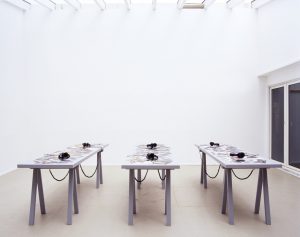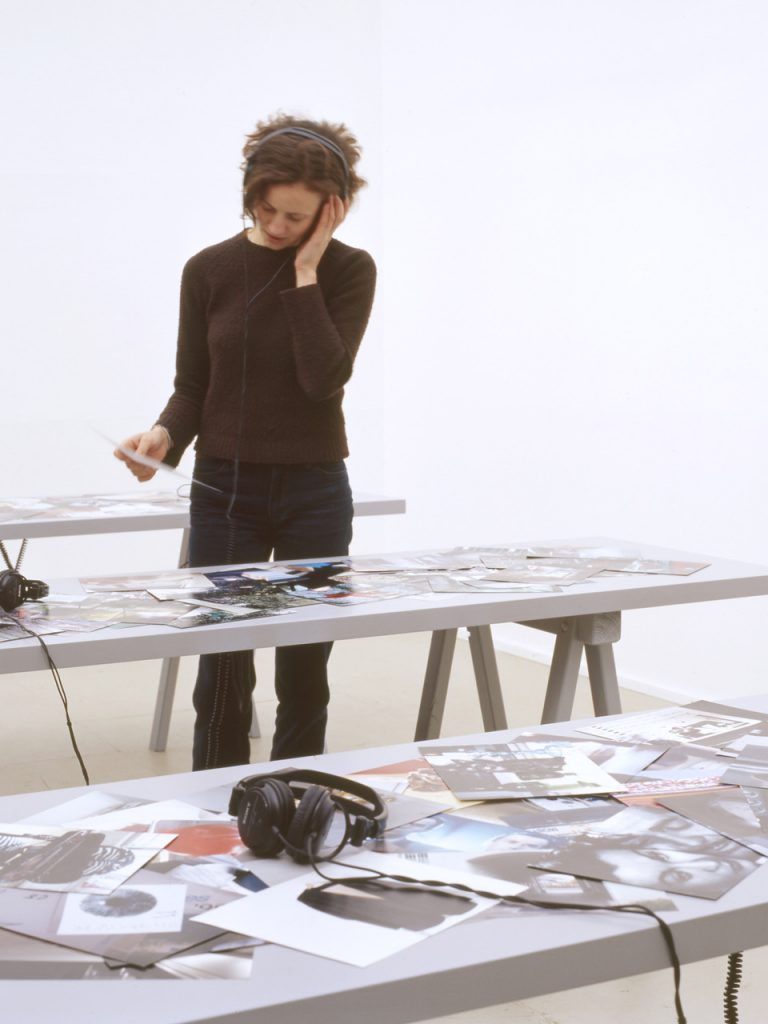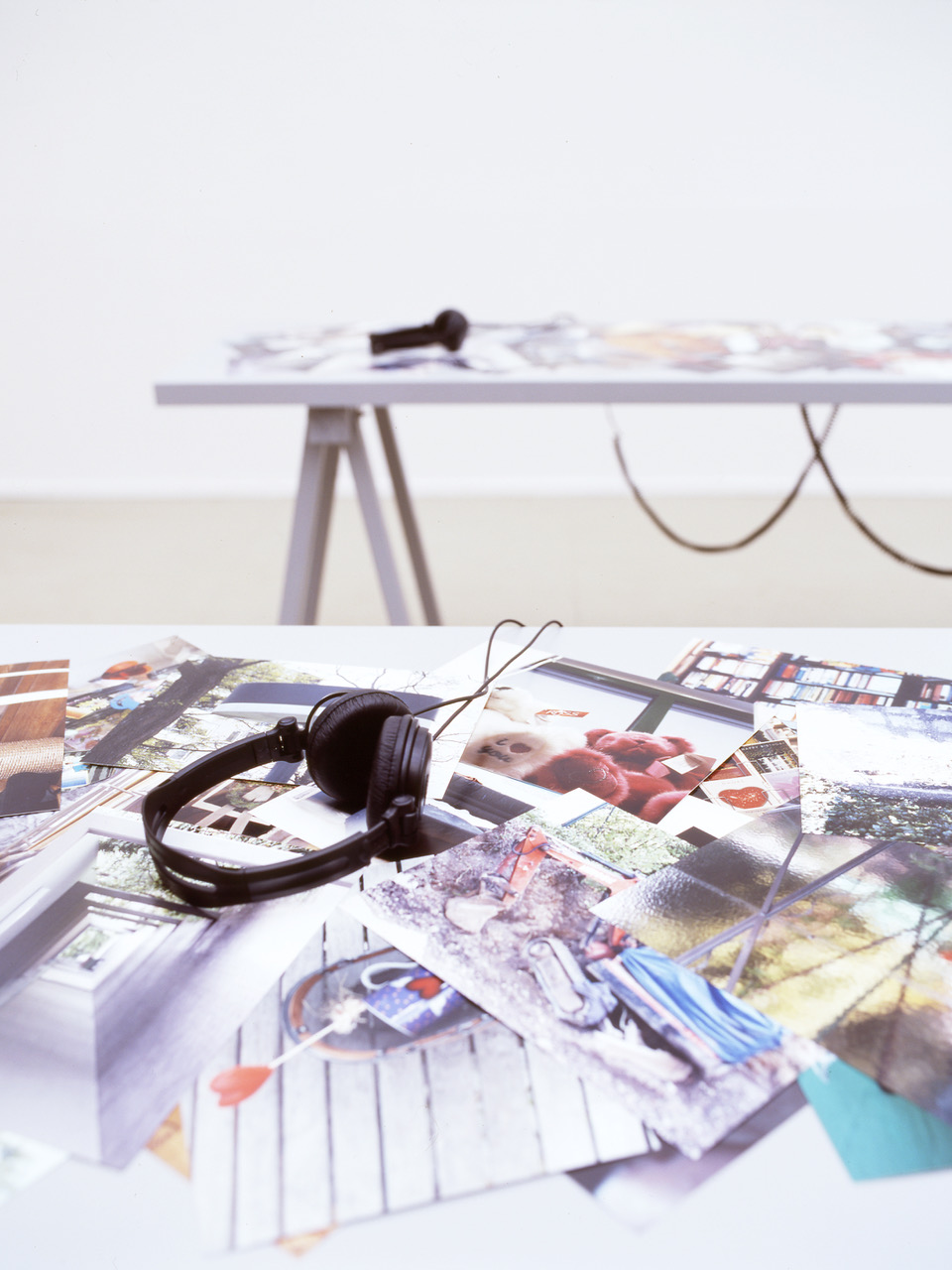PLOTS focuses on three (heterosexual) love stories and on the differences between the initial perception of an experience and its subsequent retelling. For this three-part sound installation the artist requested each of the partners to describe turning points in their mutual relationship. In an abridged form, the descriptions given by each pair were subsequently passed on to two male and two female authors, who wrote a series of fictitious scenes based on this material. The original narrations and the adapted scenes served as starting point for the installation. The installation presents the history/stories of the three couples on three adjacent tables.

To experience the installation, click the audio files below. The artist recommends using headphones to listen to the audio files.
PLOTS 1 Audio Track

PLOTS 2 Audio Track

PLOTS 3 Audio Track
Angelika Boeck
PLOTS, 2002
Audio visual Installation
3 CD’s, 3 x 54 Photos (18 x 24 cm)
Presentation: 3 tables (70 x 220 cm), 3 CD-Player, 6 headphones
http://www.angelika-boeck.de/arbeiten/alle-arbeiten/single-page-alle-arbeiten/plots/
About the Installation
(text by Randi Gunzenhäuser)
The English word “plot” can mean both a story line (of a drama) or a conspiracy, but also, as part of a language of space, pinpointing a location. Accordingly, this work is devoted to the most varied versions of three heterosexual love stories with each individual, whether they be part of the relationship or a complete stranger, giving their own account. Stories of love exercise a special fascination on us in that they offer a particularly obvious combination of personal and cultural perception. By narrating his or her story, each person acquires a share in the action, occupying narrative space vis-à-vis visitors to the exhibition and so attaining authority for his or her account.
The experimental layout makes use of the diverse meanings of the term “plot”. The starting point in each case are the two versions of the love story as recounted separately by each partner. In all, three couples were questioned on their individual versions of the story of their mutual relationship. Angelika Böck requested each of the partners to describe turning points in their mutual relationship. In an abridged form, the descriptions given by each pair were subsequently passed on to two male and two female authors, who wrote a series of fictitious scenes based on this material. The original narrations and the adapted scenes served as a starting point for the installation.
The installation presents the history/stories of the three couples on three adjacent tables. Each table represents a portrait of one of the couples. Photos of locations jointly identified by the couple as the scenes of “turning points” in their relationship lie on the table. The artist has mixed details from the couple’s personal photo album among these photos of places of dramatic importance, as well as pictorial material visualising the associations created in her own mind upon hearing the story, e.g. film stills and illustrations. Both narrative highlights and trivial incidents are presented, the couple’s own perceptions and fictionalised associations from the male and female authors, details relating specifically to the couple, but also the reactions of Angelika Böck, who acted as a mediator among these various levels.
Each table is fitted with a pair of headphones which can be put on. A female and a male off-speaker re-enact the story of the couple, followed by its fictitious adaptations. The versions of the two people involved can be heard, as well as the four different adaptations of each love story developed by outsiders. The story from the male point of view is heard from the right side of the headphones and the female perspective from the left.
The diverse plots of each love story spur visitors to the exhibition to trace the tracks of individual stories and take a stand for one side or the other. Visitors can only listen to either the man’s or the woman’s voice if they wish to understand the story. Those lending an ear to both sides of the headphones will understand nothing, the two voices blending into an incomprehensible gabble.
“Plots” evokes complex interactive processes between a man and a woman involved in a relationship. Both seemingly provide information on one and the same relationship, but through their words it becomes apparent that it is not the same relationship when recounted by two people. Although the representations coincide at times, misunderstandings are also voiced, in fact entirely different assessments of the same situation exist. Self-perception and external perception can differ drastically. This also becomes evident in the course of the fictional adaptations, which in turn offer greater scope for external perception, since the authors are in no way acquainted with the persons involved and have the possibility of freely embellishing and reassessing all that has been narrated. The clash between the perceptive criteria and ideal constellations of individuals and cultures is particularly manifest in this work.
Viewers have the possibility of choosing among the various representations, but by doing so, almost inevitably commit themselves to taking sides. In addition to the three couples who remain anonymous, twelve writers and two professional off-speakers took part in this project.
Authors
Thomas Bahmann (film director and scriptwriter)
Susanne Bienwald (writer)
Butz Buse (scriptwriter and actor)
Bettina Böck (dramatic producer)
Doris Haider (copywriter)
Klaus Heid (artist),
Gabrielle Heller (scriptwriter and actress)
Michael Hornstein (composer, saxophonist and scriptwriter)
Robert Hültner (writer)
Andrea Kästle (Journalist)
Tobias Niemann (neurobiologist)
und Fabienne Pakleppa (writer)
Off-speakers
Ditte Schupp und Jakob Ried